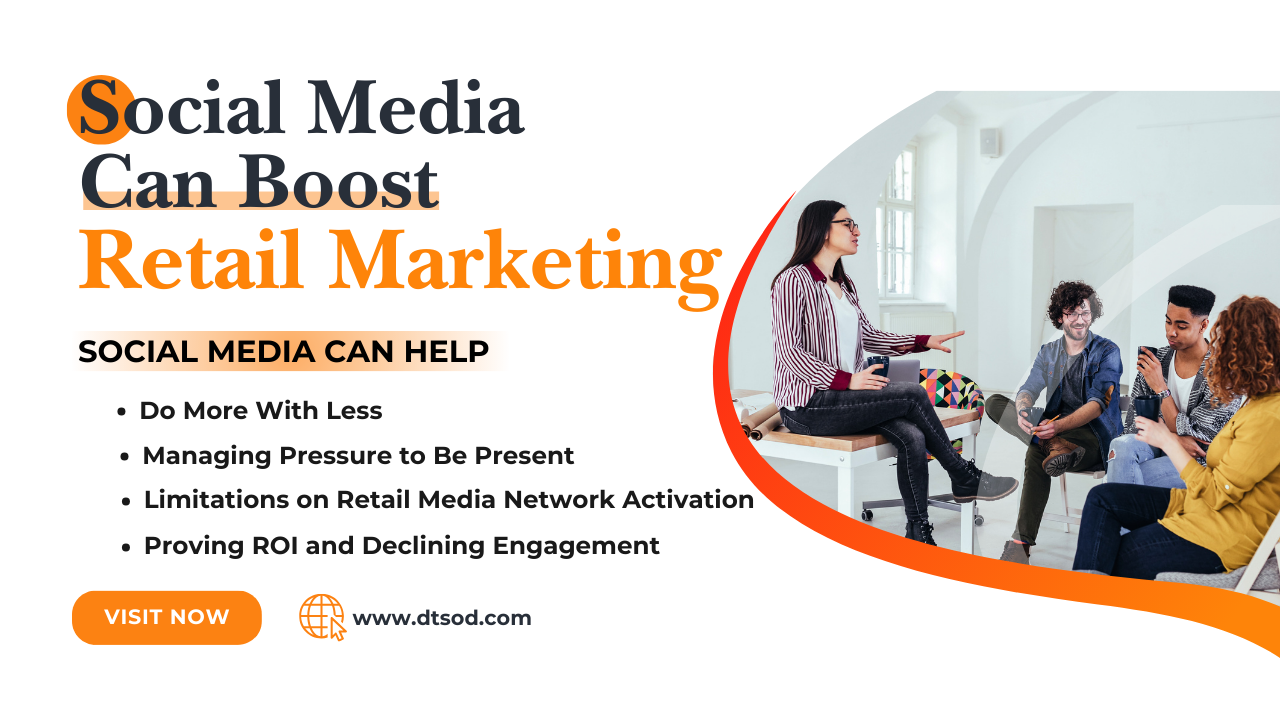From Leads to Sales: A Comprehensive Approach to Lead Generation
May 16, 2024

Feb 5, 2024
By focusing on organic social media marketing, retailers can build a brand that resonates with their target audience, reducing search advertising costs. They can also prioritize networks that align with their brand and business goals, avoid limited activation options on retail media networks, and prove ROI by creating compelling content and adapting to changing social trends. This approach can help retailers drive business without relying solely on paid ads.
Retail marketing faces several challenges in the realm of social media. Here are some of the most significant problems:
Recruiting skilled social media professionals who understand your brand voice, can create engaging content, and navigate various platforms effectively is a common challenge.
Demonstrating the tangible impact of social media efforts on business outcomes remains a hurdle. Metrics like conversions, customer lifetime value, and return on ad spend (ROAS) need to be tracked and analyzed.
As social media platforms evolve, organic reach declines. Retailers must adapt by creating compelling content that resonates with their audience and encourages interaction.
Competing with well-established brands and influencers for attention requires creativity, authenticity, and a unique value proposition. Differentiation is key.
Managing multiple social media channels can be overwhelming. Prioritize the platforms that align with your target audience and business goals.
Silos within organizations hinder effective social media strategies. Collaboration between marketing, sales, customer service, and other departments is essential.
Consistently producing fresh, relevant, and engaging content is challenging. Retailers must maintain a content calendar and explore diverse formats (videos, stories, polls, etc.
When using retail media networks, brands and agencies often face limitations in terms of activation options. Finding effective ways to leverage these networks is crucial.
Advertising costs within retail media networks can be substantial. Balancing budget constraints while achieving desired results is a delicate task.
Retail marketers encounter inconsistencies in ad formats, tracking mechanisms, and performance metrics across different platforms. Standardization would simplify measurement and optimization.
Social media isn't a magic bullet, but it is a big part of how retail marketing will change in the future. Retailers can get around these problems and connect with their audience in a useful way by using social media's broad reach, real-time interaction tools, and targeting options.
Many marketing leaders are grappling with the mandate to “do more with less.” As budgets tighten, search advertising costs may be reduced. However, organic social media marketing offers a cost-effective solution.
Despite declining organic reach on social channels, an audience-first strategy can help build a brand that resonates with the target audience. By focusing on engaging content, retailers can drive business without relying solely on paid ads.
Each social media network demands resources, and managing multiple channels can be overwhelming. Instead of being present everywhere, prioritize networks that align with your brand and business goals.
Research your target audience and competitors to identify the most relevant platforms. For instance, Facebook is popular among users aged 30 to 49, while TikTok appeals to those aged 18 to 29.
Brands and agencies face challenges when using RMNs, including limited activation options, high costs, and lack of quality verification by third parties.
Social media can provide an alternative avenue for reaching audiences without the constraints of RMNs.
Social media marketing requires demonstrating a return on investment (ROI). By tracking metrics and analyzing performance, retailers can justify their efforts.
Falling engagement rates can be countered by creating compelling content and adapting to changing social trends.
However, businesses that are ahead of the curve know that social media can be a huge help when it comes to marketing problems. As a result of its broad reach, real-time contact, and targeting features, social media has become an important tool for driving success in retail.
Influencer marketing has become a powerful strategy for retailers to connect with their target audience and drive business growth. Let’s explore how retailers can effectively utilize influencers on social media:
Micro-influencers (with smaller audiences) can be cost-effective and provide a more targeted reach. Consider collaborating with several micro-influencers to expand your impact.
Medium-sized influencers (100k to 1 million followers) offer a balance between reach and cost.
Macro-influencers (over 1 million followers) have massive audiences but may not always align perfectly with your target market.
Influencers are trusted by their followers. Their recommendations carry weight, often surpassing those from friends and family.
Leverage influencer endorsements to establish social proof for your brand and products. Authentic content created by influencers resonates with audiences.
Working with smaller influencers can be less expensive. 44% of marketers find this beneficial when compared to larger influencers.
Optimize your campaign budgets by partnering with influencers who align with your brand values and resonate with your audience.
Influencer marketing generates authentic content that builds brand awareness. It’s a powerful tool for reaching new audiences.
Consider the impact of word-of-mouth marketing: influencers you trust vs. brand advertising. Audiences often trust familiar individuals more.
Influencers inspire action. Their endorsements can lead to product purchases.
By strategically collaborating with influencers, retailers can drive sales and boost their online presence.
Remember, successful influencer marketing involves thoughtful planning, genuine partnerships, and a focus on building lasting connections with both influencers and their audiences.
Influencer marketing has become a dynamic strategy for brands to connect with their audiences. Let’s explore a few successful campaigns that showcase the power of influencers:

Chipotle, the popular fast-food chain, collaborated with influencers to promote its brand. By leveraging influencers’ authenticity and reach, Chipotle successfully engaged its target audience.

Dunkin’ Donuts partnered with TikTok sensation Charlie D’Amelio to launch “The Charli” drink. The campaign generated buzz and drove foot traffic to Dunkin’ locations.

Watch brand Daniel Wellington created a community of campus influencers. These micro-influencers shared stylish photos featuring Daniel Wellington watches, effectively reaching their peers.

Magnum collaborated with singer Halsey to promote its ice cream. The campaign emphasized indulgence and pleasure, resonating with Magnum’s brand identity
These examples demonstrate how influencer marketing can boost brand awareness, drive engagement, and inspire action. Brands that strategically partner with influencers can create memorable campaigns that resonate with their audience.
Influencer marketing can be a powerful strategy, but it’s essential to avoid common pitfalls. Let’s explore some mistakes to steer clear of:
Every business activity should have clear objectives, and influencer campaigns are no exception.
Define your goals: Do you want to increase followers, improve conversion rates, or gain user insights? Write them down as a constant reminder.
Choosing influencers solely based on follower count can backfire. Consider relevance, authenticity, and alignment with your brand.
Research their audience demographics and engagement rates.
Understand what competitors are doing in influencer marketing. Analyze their strategies and learn from their successes and failures.
Balance is key. A brief should be clear, concise, and allow creativity. Avoid micromanaging influencers.
Provide guidelines without stifling their creativity.
Metrics alone won’t suffice. Analyze the data to understand what’s working and what needs improvement.
Adjust your strategy based on insights.
Building long-term relationships with influencers is valuable. Don’t treat them as one-off transactions.
Nurture relationships beyond the campaign.
Authenticity matters. Verify an influencer’s followers to ensure they’re genuine.
Quality engagement matters more than sheer numbers.
Visual appeal is crucial. High-quality images enhance your brand’s perception.
Invest in professional content creation.
Hashtags should be relevant and accurate. Descriptions should be compelling and error-free.
Proofread and ensure consistency.
Influencer marketing isn’t just about the influencer. Engage with the audience who interacts with your brand.
Respond to comments and messages promptly.
Transparency is vital. Disclose paid partnerships clearly.
Comply with legal requirements to maintain trust.
Repetitive content won’t engage audiences. Be creative and authentic.
Showcase unique aspects of your brand through influencers.
Make sure, influencer marketing’s success lies in strategic planning, genuine connections, and a focus on long-term impact.
Measuring the success of your influencer marketing campaign for retail businesses is crucial to understanding its impact and making data-informed decisions. Let’s explore some key steps and metrics for effective measurement:
Begin by defining specific campaign goals. These goals should have both a numerical value and a deadline. For instance, instead of a vague goal like “increase web traffic,” aim for something more precise, such as “increase website visitors by 30% in 4 months.”
Challenging yet attainable goals provide focus and allow you to track progress effectively
KPIs are essential for tracking campaign success. Consider the following metrics based on your campaign objectives:
i. Brand Awareness:
Track reach, engagement, and impressions generated by influencer content.
Monitor brand mentions and comments, paying attention to sentiment.
ii. Sales and Conversion:
Measure sales made through influencers.
Use influencer-specific discount codes to track conversions.
Monitor clicks on the links promoted by influencers.
iii. Website Traffic:
Analyze visits to your website or time spent on it.
Monitor sign-ups to your site or newsletter.
iv. Overall Impact:
Consider impressions, which represent how many times the campaign content is displayed
Invest in tools that help you track and analyze influencer performance. These tools can provide insights into engagement rates, audience demographics, and overall campaign impact.
Regularly review the data and adjust your strategy as needed.
Calculate the ROI by comparing the campaign’s cost (including influencer fees, content creation, and other expenses) to the results achieved (such as sales, website traffic, or brand awareness).
A positive ROI indicates a successful campaign.
Analyze the data to understand what worked well and what needs improvement.
Adjust your approach for future campaigns based on these insights.
Keep in mind that influencer marketing is more than just having a lot of followers. It's about getting people to engage with your company in a meaningful way and reaching your retail business goals.
Social media can effectively address pressing challenges in retail marketing by maximizing impact with limited resources, prioritizing relevant platforms, telling authentic brand stories, embracing technology and personalization, and building a sustainable online presence. Skilled use can foster meaningful consumer connections.
Your Complete Guide to Hyperlocal Social Media Marketing Tactics
Why Is Understanding Your Target Audience Vital for Business Success?
Top 5 Tips for Boosting Your LinkedIn Page with Social Media Marketing
Comments